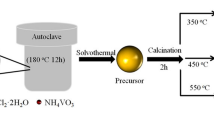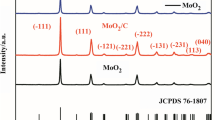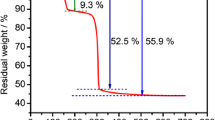Abstract
Hollow structures are an extremely attractive and special feature of nanomaterials, and they have wide application prospects in several fields, such as photocatalysis, biomedicine, energy storage, and photoelectric conversion. The synthesis of hollow nanocrystals is mainly achieved via the fine control of material nucleation, particle growth, and surface connection. According to its growth mechanism, there are typically four strategies, namely, Kirkendall effect, Ostwald ripening, chemical erosion, and template-mediated synthesis. Hollow nanostructures based on iron oxides are environmentally friendly and have high specific capacity; they can address 96% of the volume change caused by the charge-discharge cycles in lithium-ion batteries (LIBs). Thus, they have attractive application prospects as anode materials for LIBs. In this review, advances in the synthesis of hollow nanostructures based on iron oxides are summarised, and their application prospects as anode materials for LIBs, based on the above four strategies, are discussed.









Similar content being viewed by others
References
J. Xie and Y.C. Lu, A Retrospective on Lithium-Ion Batteries. Nat. Commun. 11, 2499 (2020).
J. Zhang and A. Yu, Nanostructured Transition Metal Oxides as Advanced Anodes for Lithium-Ion Batteries. Sci. Bull. 60, 823 (2015).
T. Kim, W. Song, D.-Y. Son, L.K. Ono, and Y. Qi, Lithium-Ion Batteries: Outlook on Present, Future, and Hybridized Technologies. J. Mater. Chem. A. 7, 2942 (2019).
X. Li, D. Fang, Y. Cao, Z. Luo, M. Jiang, W. Xu, and C. Xiong, Template-Sacrificed Synthesis of Polypyrrole Nanofibers for Lithium Battery. J. Mater. Sci. 51, 9526 (2016).
Y. Liu, R. Zhang, J. Wang, and Y. Wang, Current and Future Lithium-Ion Battery Manufacturing. Science 24, 102332 (2021).
M.P. Linfeng Lv, W. Leixin, D. Yixiao, Y. Gongchuan, D. Yixue, Y. Wei, H. Liang, and L. Xiaoyu, Progress in Iron Oxides Based Nanostructures for Applications in Energy Storage. Nanoscale Res. Lett. 16, 138 (2021).
Y.Y.Z. Lin, Z. Yuguang, F. Liya, W. Zi, Z. Lijun, and J. Qing, Engineering Oxygen Vacancy on Iron Oxides/Hollow Carbon Cloth Electrode Toward Stable Lithium-Ion Batteries. Chem. Eng. J. 388, 124229 (2020).
L.L. Yao Luo, Q. Wencan, L. Fan, Z. Yashan, T. Wenfeng, and Q. Guohong, Facile Crystal-Structure-Controlled Synthesis of Iron Oxides for Adsorbents and Anode Materials of Lithium Batteries. Mater. Chem. Phys. 170, 239 (2016).
J. Ying and H.L. Zhu, Liquid-Phase Synthesis of Iron Oxide Nanostructured Materials and Their Applications. Chem. A Eur. J. 10, 1002 (2020).
M. Liang, J. Zou, X. Zeng, and W. Ding, Nanostructured Fe2O3 Based Composites Prepared through Arc Plasma Method as Anode Materials in the Lithium-Ion Battery. J. Nanomater. 9, 1207907 (2016).
Q. Wu, R. Jiang, L. Mu, and S. Xu, Fe3O4 Anodes for Lithium Batteries: Production Techniques and General Applications. C. R. Chim. 22, 96 (2019).
X. Lou, J. Huang, T. Li, H. Hu, B. Hu, and Y. Zhang, Hydrothermal Synthesis of Fe3O4 and α-Fe2O3 Nanocrystals as Anode Electrode Materials for Rechargeable Li-ion Batteries. J. Mater. Sci. Mater. Electron 25, 1193 (2014).
L. Wang, G. Wei, X. Dong, Y. Zhao, Z. Xing, H. Hong, and Z. Ju, Hollow α-Fe2O3 Nanotubes Embedded in Graphene Aerogel as High-Performance Anode Material for Lithium-Ion Batteries. ChemistrySelect 4, 11370 (2019).
G.D. Park, J.H. Hong, D.S. Jung, J.-H. Lee, and Y.C. Kang, Unique Structured Microspheres with Multishells Comprising Graphitic Carbon-Coated Fe3O4 Hollow Nanopowders as Anode Materials for High-Performance Li-ion Batteries. J. Mater. Chem. A. 7, 15766 (2019).
Y. Chen, J. Wang, J. Jiang, M.A. Zhou, J. Zhu, and S. Han, Self-Assembled Graphene-Constructed Hollow Fe2O3 Spheres with Controllable Size for High Lithium Storage. RSC Adv. 5, 21740 (2015).
Y. Huang, Z. Lin, M. Zheng, T. Wang, J. Yang, F. Yuan, X. Lu, L. Liu, and D. Sun, Amorphous Fe2O3 Nanoshells Coated on Carbonized Bacterial Cellulose Nanofibers as a Flexible Anode For High-Performance Lithium Ion Batteries. J. Power Sources 307, 649 (2016).
Y. Sun, N. Liu, and Y. Cui, Promises and Challenges of Nanomaterials for Lithium-Based Rechargeable Batteries. Nat. Energy 71, 1 (2016).
S.K. Park, G.D. Park, and Y.C. Kang, Three-Dimensional Porous Microspheres Comprising Hollow Fe2O3 Nanorods/CNT Building Blocks with Superior Electrochemical Performance for Lithium Ion Batteries. Nanoscale 10, 11150 (2018).
H. Li, L.-J. Wu, S.-G. Zhang, C. Yao, C.-Y. Chao, H.-W. Yue, and H.-H. Fan, Facile Synthesis of Mesoporous One-Dimensional Fe2O3 Nanowires as Anode for Lithium Ion Batteries. J. Alloy. Compd. 832, 155008 (2020).
H. Hu, H. Cheng, J. Zhou, Q. Zhu, and Y. Yu, Hierarchical Porous Fe2O3 Assisted with Graphene-Like Carbon as High-Performance Lithium Battery Anodes. Mater. Today Phys. 3, 7 (2017).
W. Liu, J. Hu, S. Zhang, M. Deng, C.-G. Han, and Y. Liu, New Trends, Strategies and Opportunities in Thermoelectric Materials: A Perspective. Mater. Today Phys. 1, 50 (2017).
C. Chi, X. Sun, N. Xue, T. Li, and C. Liu, Recent Progress in Technologies for Tactile Sensors. Sensors (Basel). 18, 948 (2018).
Z. Wang, D. Luan, S. Madhavi, Y. Hu, and X.W. Lou, Assembling Carbon-Coated α-Fe2O3 Hollow Nanohorns on the CNT Backbone for Superior Lithium Storage Capability. Energy Environ. Sci. 5, 5252 (2012).
C. Li, A. Sarapulova, Z. Zhao, Q. Fu, V. Trouillet, A. Missiul, E. Welter, and S. Dsoke, Understanding the Lithium Storage Mechanism in Core-Shell Fe2O3@C Hollow Nanospheres Derived from Metal-Organic Frameworks: An In operando Synchrotron Radiation Diffraction and in operando x-ray Absorption Spectroscopy Study. Chem. Mater. 31, 5633 (2019).
J.-Y. Tan, J.-T. Su, Y.-J. Wu, C.-L. Huang, P.-Y. Cheng, Y.-A. Chen, and S.-Y. Lu, Hollow Porous α-Fe2O3 Nanoparticles as Anode Materials for High-Performance Lithium-Ion Capacitors. ACS Sustain. Chem. Eng.. 9, 1180 (2021).
Z. Du, S. Zhang, J. Zhao, X. Wu, and R. Lin, Synthesis and Characterization of Hollow α-Fe2O3 Spheres with Carbon Coating for Li-ion Battery. J Nanosci Nanotechnol. 13, 3602 (2013).
L.Z. Hongwei Zhang, N. Owen, J.M. Darren, K.W. Andrew, and Y. Chengzhong, Tailoring the Void Size of Iron Oxide@Carbon Yolk-Shell Structure for Optimized Lithium Storage. Adv. Funct. Mater. 24, 4337 (2014).
Z. Padashbarmchi, A.H. Hamidian, H. Zhang, L. Zhou, N. Khorasani, M. Kazemzad, and C. Yu, A Systematic Study on the Synthesis of α-Fe2O3 Multi-Shelled Hollow Spheres. RSC Adv. 5, 10304 (2015).
J.S. Cho, J.S. Park, and Y.C. Kang, Preparation of Hollow Fe2O3 Nanorods and Nanospheres by Nanoscale Kirkendall Diffusion, and Their Electrochemical Properties for Use in Lithium-Ion Batteries. Sci Rep. 6, 38933 (2016).
J.S. Cho, Y.J. Hong, J.H. Lee, and Y.C. Kang, Design and Synthesis of Micron-Sized Spherical Aggregates Composed of Hollow Fe2O3 Nanospheres for Use in Lithium-Ion Batteries. Nanoscale 7, 8361 (2015).
J. Zhang, Y. Yao, T. Huang, and A. Yu, Uniform Hollow Fe3O4 Spheres Prepared by Template-Free Solvothermal Method as Anode Material for Lithium-Ion Batteries. Electrochim. Acta 78, 502 (2012).
Z.-G. Wu, Y.-J. Zhong, J.-T. Li, X.-D. Guo, L. Huang, B.-H. Zhong, and S.-G. Sun, L-Histidine-Assisted Template-Free Hydrothermal Synthesis of α-Fe2O3 Porous Multi-Shelled Hollow Spheres with Enhanced Lithium Storage Properties. J. Mater. Chem. A. 2, 12361 (2014).
F.X. Ma, H. Hu, H.B. Wu, C.Y. Xu, Z. Xu, L. Zhen, and X.W. David Lou, Formation of Uniform Fe3O4 Hollow Spheres Organized by Ultrathin Nanosheets and Their Excellent Lithium Storage Properties. Adv Mater. 27, 4097 (2015).
Y. Cao, A.-Q. Zhang, H. Zhang, G.-Q. Ding, and L.-S. Zhang, A Facile Route to Achieve Fe2O3 Hollow Sphere Anchored on Carbon Nanotube for Application in Lithium-Ion Battery. Inorg. Chem. Commun. 111, 107633 (2020).
S. Xu, C.M. Hessel, H. Ren, R. Yu, Q. Jin, M. Yang, H. Zhao, and D. Wang, α-Fe2O3 Multi-Shelled Hollow Microspheres for Lithium Ion Battery Anodes with Superior Capacity and Charge Retention. Energy Environ. Sci. 7, 632 (2014).
K.-A. Kwon, H.-S. Lim, Y.-K. Sun, and K.-D. Suh, α-Fe2O3 Submicron Spheres with Hollow and Macroporous Structures as High-Performance Anode Materials for Lithium Ion Batteries. J. Phys. Chem. C. 118, 2897 (2014).
X. Qi, H. Zhang, Z. Zhang, Y. Bian, A. Shen, P. Xu, and Y. Zhao, Subunits Controlled Synthesis of Three-Dimensional Hierarchical Flower-like α-Fe2O3 Hollow Spheres as High-Performance Anodes for Lithium Ion Batteries. Appl. Surf. Sci. 452, 174 (2018).
M. Sun, X. Chu, Z. Wang, H. Yang, Z. Yang, J. Ma, B. Zhou, T. Yang, and L. Chen, Rosa Roxburghii-like Hierarchical Hollow Sandwich-Structure C@Fe2O3@C Microspheres as Second Nanomaterialsfor Superior Lithium Storage. J. Alloy. Compd. 855, 157518 (2021).
X. Ma, L. Huang, F. Wu, S. Xiong, and B. Xi, Formation of C@Fe3O4@C Hollow Sandwiched Structures with Enhanced Lithium-Storage Properties. Eur. J. Inorg. Chem. 2016, 3722 (2016).
C. Fu, A. Mahadevegowda, and P.S. Grant, Production of Hollow and Porous Fe2O3 from Industrial Mill Scale and its Potential for Large-Scale Electrochemical Energy Storage Applications. J. Mater. Chem. A. 4, 2597 (2016).
X.-Y.Y. and Zhiming Liu, Ungyu Paik Etching-in-a-Box: A Novel Strategy to Synthesize Unique Yolk-Shelled Fe3O4 @Carbon with an Ultralong Cycling Life for Lithium Storage. Adv. Energy Mater. 6, 1502318 (2016).
S. Hao, B. Zhang, S. Ball, J. Wu, M. Srinivasan, and Y. Huang, Phase Transition of Hollow-Porous α-Fe2O3 Microsphere based Anodes for Lithium Ion Batteries During High Rate Cycling. J. Mater. Chem. A. 4, 16569 (2016).
Z. Zheng, Y. Zao, Q. Zhang, Y. Cheng, H. Chen, K. Zhang, M.-S. Wang, and D.-L. Peng, Robust Erythrocyte-like Fe2O3@Carbon with Yolk-Shell Structures as High-Performance Anode for Lithium Ion Batteries. Chem. Eng. J. 347, 563 (2018).
J. Lian, K. Anggara, M. Lin, and Y. Chan, Formation of Hollow Iron Oxide Tetrapods via a Shape-Preserving Nanoscale Kirkendall Effect. Small 10, 667 (2014).
K. Cheng and S. Sun, Recent Advances in Syntheses and Therapeutic Applications of Multifunctional Porous Hollow Nanoparticles. Nano Today 5, 183 (2010).
H. Khurshid, W. Li, V. Tzitzios, and G.C. Hadjipanayis, Chemically Synthesized Hollow Nanostructures in Iron Oxides. Nanotechnology 22, 265605 (2011).
S. Gurmen and B. Ebin, Production and Characterization of the Nanostructured Hollow Iron Oxide Spheres and Nanoparticles by Aerosol Route. J. Alloy. Compd. 492, 585 (2010).
S. Sheng, H. Gao, X. Liu, Z. Wang, and Y. Zhao, Rational Fabrication and Improved Lithium Ion Battery Performances of Carbon Nanofibers Incorporated with α-Fe2O3 Hollow Nanoballs. Surfaces Interfaces 21, 100612 (2020).
X. Xu, J. Park, Y.-K. Hong, and A.M. Lane, Ethylene Glycol Assisted Spray Pyrolysis for the Synthesis of Hollow BaFe12O19 Spheres. Mater. Lett. 144, 119 (2015).
W.M.D. Wenshou, and Y. Yadong, Hollow Nanocrystals through the Nanoscale Kirkendall Effect. Chem. Mater 10, 1179 (2013).
B. Koo, H. Xiong, M.D. Slater, V.B. Prakapenka, M. Balasubramanian, P. Podsiadlo, C.S. Johnson, T. Rajh, and E.V. Shevchenko, Hollow Iron Oxide Nanoparticles for Application in Lithium Ion Batteries. Nano Lett. 12, 2429 (2012).
L. Yu, R. Han, X. Sang, J. Liu, M.P. Thomas, B.M. Hudak, A. Patel, K. Page, and B.S. Guiton, Shell-Induced Ostwald Ripening: Simultaneous Structure, Composition, and Morphology Transformations during the Creation of Hollow Iron Oxide Nanocapsules. ACS Nano 12, 9051 (2018).
Z.K.L. Liangpeng, W. Hua, Y. He, Z. Xing, W. Yonggang, N. Peihong, S. Congzhi, and L. Yongming, CO Oxidation on Au/#-Fe2O3-Hollow Catalysts: General Synthesis and Structural Dependence. J. Phys. Chem. C. 20036, 1 (2017).
D. Li, R. Xu, Y. Jia, P. Ning, and K. Li, Controlled Synthesis of α-Fe2O3 Hollows from β-FeOOH Rods. Chem. Phys. Lett. 731, 136623 (2019).
R. Wei, Y. Xu, and M. Xue, Hollow Iron Oxide Nanomaterials: Synthesis, Functionalization, and Biomedical Applications. J. Mater. Chem. B. 9, 1965 (2021).
J. Huang, Y. Li, X. Jia, and H. Song, Preparation and Tribological Properties of Core-Shell Fe3O4@C Microspheres. Tribol. Int. 129, 427 (2019).
R. Ma, M. Wang, D.T. Dam, Y. Dong, Y. Chen, S.K. Moon, Y.J. Yoon, and J.M. Lee, Halide-Ion-Assisted Synthesis of Different α-Fe2O3 Hollow Structures and Their Lithium-Ion Storage Properties. ChemPlusChem 80, 522 (2015).
B. Wang, J.S. Chen, H.B. Wu, Z. Wang, and X.W. Lou, Quasiemulsion-Templated Formation of α-Fe2O3 Hollow Spheres with Enhanced Lithium Storage Properties. J. Am. Chem. Soc. 133, 17146 (2011).
Y. Kim, E. Choi, J.G. Kim, S. Lee, W. Yoon, M.-H. Ham, and W.B. Kim, Size-Controlled Hollow Spheres of C/α-Fe2O3 Prepared through the Quasiemulsion-Templated Method and Their Electrochemical Properties for Lithium-Ion Storage. ChemElectroChem 4, 2045 (2017).
Z. Nie, Y. Wang, Y. Zhang, and A. Pan, Multi-Shelled α-Fe2O3 Microspheres for High-Rate Supercapacitors. Sci. China Mater. 59, 247 (2016).
R. Riasat and G. Nie, Synthesis and Characterization of Nontoxic Hollow Iron Oxide (α-Fe2O3) Nanoparticles Using a Simple Hydrothermal Strategy. J. Nanomater. 2016, 1920475 (2016).
Z. Zhao, X. Liu, C. Luan, X. Liu, D. Wang, T. Qin, L. Sui, and W. Zhang, Architecting Hierarchical Shell Porosity of Hollow Prussian Blue-Derived Iron Oxide for Enhanced Li Storage. J. Microsc. 276, 53 (2019).
X. Zheng, X. Yan, Y. Sun, Y. Yu, G. Zhang, Y. Shen, Q. Liang, Q. Liao, and Y. Zhang, Temperature-Dependent Electrochemical Capacitive Performance of the α-Fe2O3 Hollow Nanoshuttles as Supercapacitor Electrodes. J. Colloid Interface Sci. 466, 291 (2016).
Y. Wu, H. Yu, F. Peng, and H. Wang, Facile Synthesis of Porous Hollow Iron Oxide Nanoparticles Supported on Carbon Nanotubes. Mater. Lett. 67, 245 (2012).
M. Qiu, R. Wang, and X. Qi, Hollow Polyhedral α-Fe2O3 Prepared by Self-Assembly and Its Photocatalytic Activities in Degradation of RhB. J. Taiwan Inst. Chem. Eng. 102, 394 (2019).
D.D. Vuong, L.H. Phuoc, V.X. Hien, and N.D. Chien, Hydrothermal Synthesis and Ethanol-Sensing Properties of α-Fe2O3 Hollow Nanospindles. Mater. Sci. Semicond. Process. 107, 104861 (2020).
J.M. Jeong, B.G. Choi, S.C. Lee, K.G. Lee, S.J. Chang, Y.K. Han, Y.B. Lee, H.U. Lee, S. Kwon, G. Lee, C.S. Lee, and Y.S. Huh, Hierarchical Hollow Spheres of Fe2O3 @polyaniline for Lithium Ion Battery Anodes. Adv Mater. 25, 6250 (2013).
V.L. De Los Santos, D.A. Bustamante, F.L. León, J.B. Kargin, D.G. Mukhambetov, A.L. Kozlovskiy, N.O. Moreno, S.J. Flores, R. Castellanos Cabrera, and C.H.W. Barnes, Characterization and Magnetic Properties of Hollow α-Fe2O3 Microspheres Obtained by Sol Gel and Spray Roasting Methods. J. Sci. Adv. Mater. Devices 4, 483 (2019).
A. Papaderakis, I. Mintsouli, J. Georgieva, and S. Sotiropoulos, Electrocatalysts Prepared by Galvanic Replacement. Catalysts 7, 80 (2017).
Y.L. Ding, Y. Wen, P.A. van Aken, J. Maier, and Y. Yu, Rapid and Up-Scalable Fabrication of Free-Standing Metal Oxide Nanosheets for High-Performance Lithium Storage. Small 11, 2011 (2015).
M. Akia, K.A. Mkhoyan, and K. Lozano, Synthesis of Multiwall α-Fe2O3 Hollow Fibers Via a Centrifugal Spinning Technique. Mater. Sci. Eng. C 102, 552 (2019).
X. Xia, Y. Wang, A. Ruditskiy, and Y. Xia, 25th Anniversary Article: Galvanic Replacement: a Simple and Versatile Route to Hollow Nanostructures With Tunable and Well-Controlled Properties. Adv Mater. 25, 6313 (2013).
L. Zhang, H.B. Wu, and X.W.D. Lou, Iron-Oxide-Based Advanced Anode Materials for Lithium-Ion Batteries. Adv. Energy Mater. 4, 1300958 (2014).
Funding
This study was funded by the National Natural Science Foundation (Grant Number 61764007 and 62041107), and two Jiangxi Provincial Innovation Fund projects (Project Number YC2021-S548 and YC2021-S546).
Author information
Authors and Affiliations
Corresponding authors
Ethics declarations
Conflict of interest
Author HUA ZHU has received research Grants from National Natural Science Foundation, Author SHIJIN YU is currently working at the School of Mechanical and Electronic Engineering at Jingdezhen Ceramic University. On behalf of all authors, the corresponding author states that there is no conflict of interest.
Additional information
Publisher's Note
Springer Nature remains neutral with regard to jurisdictional claims in published maps and institutional affiliations.
Rights and permissions
About this article
Cite this article
Zhu, H., Wei, Q., Yu, S. et al. Synthesis of Hollow Nanostructures Based on Iron Oxides and Their Applications in Lithium-Ion Batteries. J. Electron. Mater. 51, 4207–4223 (2022). https://doi.org/10.1007/s11664-022-09680-x
Received:
Accepted:
Published:
Issue Date:
DOI: https://doi.org/10.1007/s11664-022-09680-x




